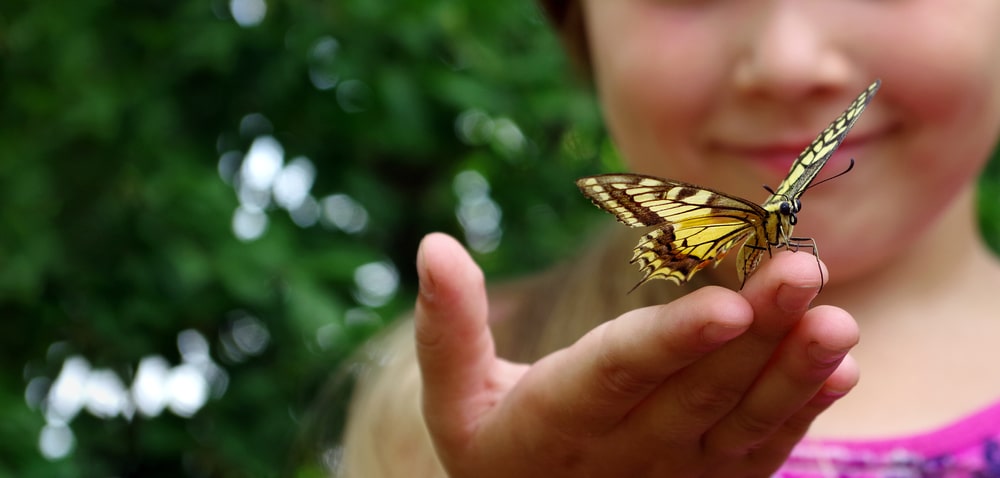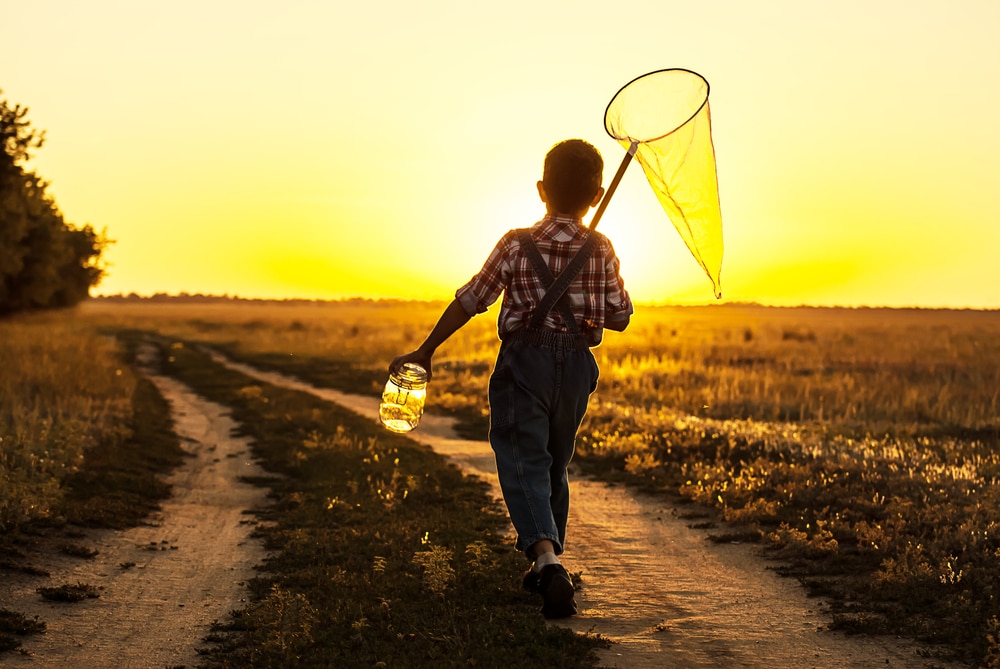Butterflies are stunning, so you may find yourself tempted to touch one. They’re pretty soft, though, like flower petals, so can you touch butterflies? Will that harm or even kill them?
You can touch butterflies, but you’ll want to do it very carefully. Butterflies are as fragile as they look and can get seriously damaged (or even die) if you don’t touch them correctly. The best method is to allow them to naturally land on the back of your hand.
Why You Must Touch Butterflies Carefully

Butterflies are very important to our world. They help plants reproduce, many of which we enjoy or even eat.
Butterflies are also quite delicate, with soft wings and even softer bodies. It’s easy to squish them if you’re not careful. Moreover, tiny scales make up their wings, and the scales can fall off easily.
These scales will look like dust when they come off. If too many scales fall off, the affected wing will be irreparably damaged, inhibiting the butterfly’s ability to fly. This will make it difficult for the butterfly to reach food or avoid predators, significantly shortening its lifespan.
Ground Rules For Touching Butterflies
The safest thing to do is simply let a butterfly land on the back of your hand. This ensures they don’t lose any scales, and you can hold them for as long as they stick around!
The Best Places To Find Butterflies Outside Your Yard
The best butterfly hotspots are meadows and forest clearings. You’ll want to go on a sunny day. Butterflies love the sun, so they’ll be most plentiful then.
On that sunny day, look for areas with plenty of flowers. Look for butterfly favorites such as black-eyed Susans, coneflowers, violets, and sunflowers.
You can also find butterflies in your yard, but unless you have a butterfly garden or have taken steps to attract butterflies, you’re far less likely to see one there.
The Best Time Of Year To Find Butterflies
The best time to go butterfly-hunting is spring through late autumn in most climates. Warmer climates are the exception, as they may still have flowers and butterflies in the winter.
How To Catch Butterflies Without Harming Them

If you’d like to touch a butterfly, you’ll need to gently catch it. You can do this with a butterfly net or by hand!
Catch A Butterfly With Your Hand
As mentioned before, attracting a butterfly to the back of your hand is the best way to touch one safely. For butterflies, it’s much less stressful. They’re choosing to land on you rather than being caught, and it’s a pretty indescribable feeling to be able to hold a butterfly this way.
To help you enjoy this same feeling, here are some tips to make it happen:
- Wear colorful clothing: Butterflies love colorful flowers, and colorful clothing mimics their appearance.
- Skip the unnatural scents: Cologne is one such example.
- Use scents they like: These include essential oils and sweet perfumes, like lavender, vanilla, or rose.
- Use sugar water: Place some on the back of your hand and wait.
- Nectar rings are another option: You can wear these. While they’re typically for hummingbirds, some are also suitable for butterflies.
- Use fruit: Put some cut pieces of fruit (some butterfly favorites are super-ripe oranges, peaches, and strawberries) on your hand.
- Avoid talking: Butterflies don’t make sounds, and voices come off as threatening.
- Remain still: Any kind of movement can scare butterflies away. So, take a deep breath, relax, and wait.
Catch A Butterfly With A Net
Butterfly nets are a great way to catch butterflies (just so long as you quickly free them after catching them). This is the quickest and easiest way to catch a butterfly. The nets are soft yet sturdy, so they’ll keep butterflies from escaping without harming them.
I have just a couple of tips for catching butterflies with a butterfly net:
- Pick the right one: Catching a perched butterfly is much easier than one in flight.
- Move slowly: Like most wild creatures, butterflies are startled by fast movements. You’ll want to sneak up on them with slow, methodical movements.
- Relax: They may also be able to sense if you’re tense, so try to relax!
- Catch Them Properly: When you sweep the net toward the butterfly, be careful but swift. Sweep from the side, catch the butterfly, and then hold the net shut (or twist it shut very carefully).
Are There Any Poisonous Butterflies You Should Avoid?
Butterflies are not poisonous to humans. Butterflies lack fangs and stingers, and the powder on their wings isn’t poisonous, either. Unless you eat one, there’s nothing to worry about.
Butterflies are only poisonous to predators looking to eat them, as they can contain toxins in their bodies from what they eat (for example, monarch butterflies and milkweed).
How To Attract Butterflies To Your Yard

Everyone has a butterfly fly through occasionally, but what if you had many butterflies around? If you want to touch and interact with a butterfly, you can save yourself a drive or hike by attracting them right to your yard.
The good news is there are plenty of ways to do this.
Let’s start with what flowers to plant.
Plant Butterflies’ Favorite Flowers
The first and most effective way to bring butterflies to your yard is to plant their favorite flowers. These are the most colorful, fragrant, and nectar-rich flowers. Here are a few of butterflies’ most-loved flowers, along with why:
- Purple coneflowers: These flowers’ vibrant color and abundant nectar draw butterflies in. The flowers’ centers provide butterflies with the perfect landing pad.
- Joe-Pye weed: Joe-Pye weed grows in little clusters of tiny, trumpet-shaped flowers. These flowers are the perfect shape for butterflies to drink from (like butterfly-sized cups). Joe-Pye weed also comes in red-purple and pink (which butterflies are quite drawn to).
- Milkweed: Milkweed is renowned for its vast appeal to the stunning monarch butterfly. In fact, monarch butterflies depend on milkweed. It’s their host plant, meaning they lay their eggs on it. Plant milkweed, and you’ll have monarch butterflies showing up each year!
- Lavender: Butterflies and bees love lavender. This is because the pretty purple spires are made up of hundreds of tiny, nectar-stuffed flowers.
- Goldenrod: Goldenrod is bright yellow, which draws butterflies in. Goldenrod bunches are dense with fragrance and nectar.
You can plant additional plants to draw in other pollinators too. You can also plant flowers to attract butterflies but not bees if you’re wary of the latter.
You have tons of options!
Offer Them Sugar Water From Your Butterfly Feeder
The next best thing you can do to welcome butterflies into your yard is to offer them sugar water from a feeder.
The recipe is simple since you only need to boil sugar and water together. The best ratio is three teaspoons (tsp) of sugar for every one cup of water. Make a few cups to fill your feeder.
You can buy or make one if you don’t have a feeder.
Offer Them Water In A Butterfly-Safe Way
In the warm, thirsty spring and summer months, butterflies may have difficulty finding viable water sources. Butterflies can’t swim or stand on water either, meaning they avoid lakes, ponds, and other familiar water sources.
Instead, butterflies drink from mud. This is called “puddling.” Butterflies drinking this way gives them a reliable surface to stand on.
You can always provide some mud water to encourage butterflies to hang around your yard. All you need is some sort of shallow dish, sand or soil, and water.
Fill the dish with a few inches of sand/soil, then soak the sand thoroughly. You’ll want a water depth of just a couple of centimeters over the sand/soil. Place the mud water somewhere sunny, so the butterflies can stay warm while they drink!
Make The Butterflies A Handy Salt Lick
While butterflies get plenty of sugar from nectar, they don’t get any salt from it. Because they require this nutrient, they must obtain it from supplemental sources, like sweat, manure, or mud. You can make a salt lick if you’d like to encourage butterfly visitors.
All you need to do is add 1-2 tablespoons (tbsp) of salt to the sand or soil when you provide them with mud water (this process is described in the above section)!
Final Advice
Butterflies are just as beautiful as they are fragile. There’s a lot to know about how to touch and attract them. So, use only a few tips at a time, and don’t get discouraged if you don’t see results immediately. Soon enough, you’ll enjoy the special bond between you and a butterfly.


